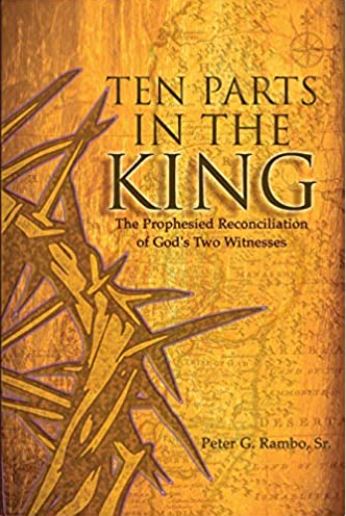Jewish objection to the Angel of the Lord being Divine usually hinges on one of two points: man can’t see God and the Lord is ‘one.’ In this missive we’ll see that one of those points, that man cannot see God, is utterly put to rest.
The first appearance of the Angel of the Lord, at least as described by that specific title, is  in Genesis 16. Hagar, treated harshly by Sarai, had fled into the desert and the Angel of the Lord finds her resting by a spring.
in Genesis 16. Hagar, treated harshly by Sarai, had fled into the desert and the Angel of the Lord finds her resting by a spring.
7 Now the angel of the Lord found her by a spring of water in the wilderness, by the spring on the way to Shur. 8 He said, “Hagar, Sarai’s maid, where have you come from and where are you going?” And she said, “I am fleeing from the presence of my mistress Sarai.” 9 Then the angel of the Lord said to her, “Return to your mistress, and submit yourself to her authority.” 10 Moreover, the angel of the Lord said to her, “I will greatly multiply your descendants so that they will be too many to count.”
The Angel of the Lord, using first person singular: ‘I’, says that He will greatly multiply her descendants. This is very similar terminology to what we see in Genesis 12:2 when YeHoVaH says to Abram, “I will make you a great nation, I will bless you..” Essentially, the Angel of the Lord assumes to Himself the exact same authority and power that we see in the mouth of Yehovah, just four chapters earlier. Clearly, this Angel of the Lord is no ordinary ‘angel,’ or more correctly, messenger. The conversation continues,
11 The angel of the Lord said to her further,
“Behold, you are with child,
And you will bear a son;
And you shall call his name Ishmael,
Because the Lord has given heed to your affliction.
12 “He will be a wild donkey of a man,
His hand will be against everyone,
And everyone’s hand will be against him;
And he will live to the east of all his brothers.”
13 Then she called the name of the Lord who spoke to her, “You are a God who sees”; for she said, “Have I even remained alive here after seeing Him?” 14 Therefore the well was called Beer-lahai-roi; behold, it is between Kadesh and Bered.
BOOM!
Did you see that?
Even, both the Schottenstein and Stone Chumash render verse 13 as,
And she called the name of Hashem who spoke to her…
In spite of both immediately trying to explain away the significance of this phrase in their respective commentary, the clear declaration of the text and the clear understanding of Hagar is that when she spoke with the Angel of the Lord, she was speaking to God! Further, she unambiguously says,
“Have I even remained alive here after seeing Him?”
Folks, Christendom has lots of theological contortions they go through to dodge uncomfortable truths. This is one of those most uncomfortable truths that Judaism seeks to dodge.
Simply, Hagar saw God and she knew it! (We’ll tackle Judges 13 later, but take a quick peek at v. 22 for confirmation that Hagar is not alone in her understanding, experience or conclusions. Judges 6:22 has a similar confirmation.)
A side point that I find interesting is that Hagar is amazed that she saw God (the Angel of the Lord) and yet lives. To my knowledge, the Torah had not revealed any sort of injunction against seeing God, yet she clearly understands this to be a terrifying truth. This is evidence that they knew much more than is revealed up to this point in Scripture. Indeed, the bread crumb trail of evidence in Genesis indicates that they had all of the Torah prior to our hearing it from Sinai! But, I digress.
Considering the fact that we cannot see God, in Exodus 33, we read,
18 Then Moses said, “I pray You, show me Your glory!” 19 And He said, “I Myself will make all My goodness pass before you, and will proclaim the name of the Lord before you; and I will be gracious to whom I will be gracious, and will show compassion on whom I will show compassion.” 20 But He said, “You cannot see My face, for no man can see Me and live!” 21 Then the Lord said, “Behold, there is a place by Me, and you shall stand there on the rock; 22 and it will come about, while My glory is passing by, that I will put you in the cleft of the rock and cover you with My hand until I have passed by. 23 Then I will take My hand away and you shall see My back, but My face shall not be seen.”
So, what did Hagar see?
Messianic Rabbi Itzahk Shapira, like many in Judaism, would argue that Hagar saw a manifestation of God, while Christendom would call this a Christophany, or pre-incarnate appearing of Christ. While both would be true, neither is a completely satisfying explanation. Shapira’s because the Angel speaks from himself with full authority and a manifestation does not take into account the correct definition of ‘echad’ as we find the Almighty explained in the Shema. The Christophany is not necessarily satisfying precisely because Christendom does not act as if this is ‘Jesus Christ, the same yesterday, today and forever’ as Hebrews 13:8 tells us. (If the Angel of the Lord is a Christophany, as they claim, then Christendom’s view of Jesus and the Torah gets utterly disassembled in Judges 2:1-4… but we’ll save that for another part of this series.)
Regardless of the explanations and theological hoops, the simple text says,
13 Then she called the name of the Lord who spoke to her, “You are a God who sees”; for she said, “Have I even remained alive here after seeing Him?”
The only reasonable conclusion, one explicitly stated in the text, is that the Angel of the Lord is God. This point will become more apparent as we proceed.
A closing thought: Why do we find it so hard to comprehend a God who loves His people so much that He often reveals Himself in ways that they/we can have tangible evidence of His nearness and involvement in our lives. While the significance and Person of the Angel of the Lord is key for Christendom to understand Yeshua’s relationship to the Torah, these manifestations are equally important for Judaism in understanding that the same God who showed Himself as a pillar of cloud and a pillar of fire can also show Himself as a Divine Man who can interact relationally with his creation.
Truly, understanding the significance of the Angel of the Lord is significant in tearing down and bypassing the traditions of men we have been taught. The simple truth of the Word is ever so much more exciting than mans explanations about why it doesn’t mean what it says.
Shavua tov!!




















































































































Pete! These may be the most significant words you have written in all the years of natsab:
“While the significance and Person of the Angel of the Lord is key for Christendom to understand Yeshua’s relationship to the Torah, these manifestations are equally important for Judaism in understanding that the same God who showed Himself as a pillar of cloud and a pillar of fire can also show Himself as a Divine Man who can interact relationally with his creation.”
So this Angel of the Lord series is going to be a book, right?
LikeLiked by 1 person
Actually, after I had studied and understood the Angel of the Lord, I found and read a neat book titled “Who ate lunch with Abraham?”
While I live the book and it’s specific target toward Jews, the author errs in stating that Torah is optional for nob-Jews. Otherwise, great little book.
LikeLiked by 1 person
Ah, Asher Intrater. He has many good insights. I enjoy his teaching, although we do have some points of disagreement.
LikeLike